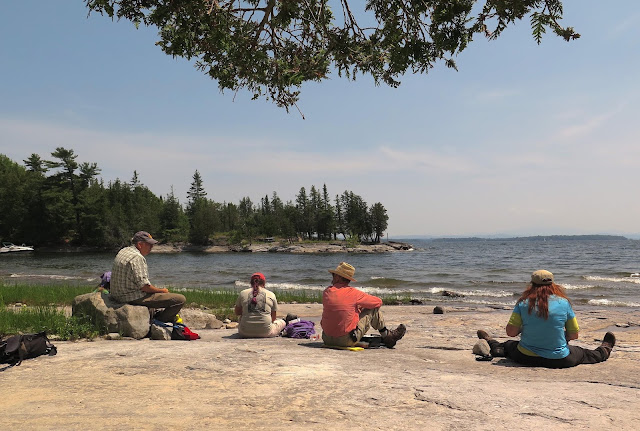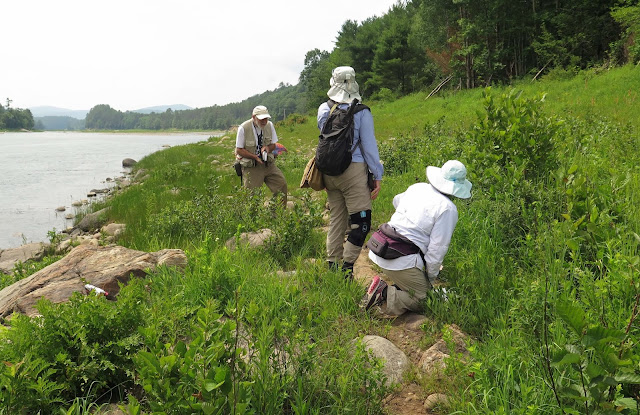Just because I haven't posted a blog for a week, it doesn't mean I haven't been out wandering the woods and waterways. On the contrary, I've been wandering so much and so far afield, I haven't had time to sit down and write, let alone edit the hundreds of photos of all the marvels I encountered. If I posted all my photos, I think I would use up all of my blogger allotment, so here are just a few of the highlights of my week-ful of wanderings.
Tuesday, July 9: Whiteface Mountain
Yes, I know I was just up on the summit of Whiteface Mountain only about 10 days before. But on that date (June 28), the wee little pyrola called Lesser Shinleaf (Pyrola minor) was still in tight bud, and darn it all, I just HAD to have a photo of it in bloom! So up I went once more, again paying the $16 toll to drive to the summit, which is the only location in all of New York State that this Endangered species is currently known to grow. Wildflower nut that I am, finding and photographing the flowers in bloom was worth the price of admission.
Granted, the lowest-growing globular florets don't look that much different from the globular buds still closed at the top of the stalk. But that's what the florets of this particular species look like: short and round and with no protruding stamens.
Mission accomplished, I then looked around at some of the other changes since my visit in late June. When I spotted this patch of Bearberry Willow (Salix uva-ursi), a low-growing dwarf willow of alpine habitats, I had a quick delusion that snow had fallen on them (hey, snow falls on mountaintops late in the year!). But of course, it was only the willow catkins covered with the fluff that would carry the seeds on the wind.
On my previous visit, I'd found clumps of the grass-fine leaves of Mountain Sandwort (Mononeuria groenlandica) tucked in among the boulders. They were studded with tight green buds at that time, but today they were starred with the small white flowers that inspired their common name. This is another rare plant that thrives only in alpine habitats.
Wednesday, July 10: Valcour Island in Lake Champlain
Here are my boat-mates Ruth Brooks, Dan Spada, Gary Lee, and Nancy Slack, bouncing across the choppy waters of Lake Champlain as we head toward Valcour Island, a limestone underlaid paradise of rare plants that lies not far offshore. Ruth is a fellow passionate plant enthusiast and a diligent student and documentarian of all the plants she finds; Dan is a retired resource analyst for the Adirondack Park Agency; Gary is a retired Forest Ranger from the Department of Environmental Conservation; and Nancy is a bryologist and former professor of ecology at the College of Russell Sage.
The folks on this foray, co-sponsored by the New York Flora Association and the Adirondack Botanical Society, represented a vast compendium of knowledge about New York flora. That knowledge soon would be put to the test when we came upon the rather weedy-looking plant Steve Young, chief botanist with the New York Natural Heritage Program, is here keying out. With modern technology, we can now carry all the information contained in the comprehensive botanical tomes and manuals right at hand in our pockets!
As it turned out, this plant was certainly worth the pondering, since Steve was ultimately able to confidently assert that it was, indeed, the Endangered species Lactuca hirsuta (Tall Hairy Lettuce), an extremely rare plant that hadn't been reported from Valcour Island since 1965. I wasn't in on the discussions about the plant's fine points, but I did learn that the brick-red opening flower petals were among its diagnostic features.
We found many other interesting plants on the island, but this False Indigo (Amorpha fruticosa) was among the few that were new to me. I have toured this island twice before, but both times earlier in the year, so I would not then have seen these flower heads of a remarkable purple-blue color, beautifully in bloom on this day.
What a spot for a picnic, eh? And we couldn't have had a more beautiful day to enjoy the cooling breeze on the tree-lined shore of Valcour Island.
All around us there, in the grassy verge that edged the rocky shore, were dozens of the small native orchid called Shining Ladies' Tresses (Spiranthes lucida), the lower petals of its tiny white florets streaked with golden yellow.
I did have a few distressing moments when I failed to notice my fellow botanizers leaving the trail to spread out to explore a swamp, and after I'd blithely continued on a bit, I found myself alone on the trail far from where I'd last seen my companions. My momentary anxiety was relieved by the sight of this gorgeous Luna Moth resting on the leaf litter. And of course, we all did find one another at last!
Thursday, July 11: The Ice Meadows along the Hudson River in Warren County
If there's any place in northeastern New York that could rival Valcour Island for the number and variety of rare plants that inhabit it, a stretch of Hudson River banks north of Warrensburg called the Ice Meadows would probably be it. During the winter, a special kind of ice called "frazil" piles up on these shores in impressive heaps, sometime to 12 or 15 feet or more. Both the weight and the chilling effect of all that ice have created a habitat ideally suited for plants that have evolved to endure such harsh conditions. Our group of plant enthusiasts called The Thursday Naturalists visits this site every year, and last Thursday was the day we did it.
We had barely cleared the forest and stepped out onto the sunny meadow when we saw masses of pretty pink orchids called Rose Pogonia (Pogonia ophioglossoides) starring the grass. One of New York's prettiest orchids, it is also one of the commonest and easiest to find, since it can tolerate both acidic and basic conditions. And this particular stretch of river bank, with its acidic rock that is watered by springs that deliver mineral-rich water to standing pools, offers both conditions. So we find lots and lots of Rose Pogonia here.
Here's a closer look at the pretty pink Rose Pogonia.
Other orchids grow here too, including the Little Clubspur Orchid (Platanthera clavellata), which was almost ready to open its buds on the day we were here. We did not find several other orchid species we've found here in the past (Tubercled Orchid, Smaller Purple-fringed Orchid, and Ragged Fringed Orchid). Perhaps they had not yet come into bloom.
We did, however, find lots and lots of the wee little puffy-white blooms of Sticky Tofieldia (Triantha glutinosa), an Endangered species that has been reported from only 3 other counties in the state.
Many interesting grasses and sedges also grow happily here, with Buxbaum's Sedge (Carex buxbaumii), a Threatened species in New York, probably being among the rarest of them.
We were just in time to find the carnivorous little sundews in bloom, both the Spatulate-leaved Sundew pictured here (Drosera intermedia), and the Round-leaved Sundew (D. rotundifolia), which had flowers a little bit smaller than these. Both sundews attract insects to their sparkling leaves, which trap the insects with sticky fluid as the leaves curl over them and hold them in place for the plants to consume.
Masses of tiny white Large Cranberry flowers (Vaccinium macrocarpon) bloomed amid the boulders along the shore.
The lovely purple-flowered Harebell (Campanula rotundifolia) thrives here in this harsh habitat, despite its delicate appearance.
And if Harebells appear to be delicate, these tiny little Marsh Bellflowers (Campanula aparinoides) appear to be even more so, with their weak thread-like stems that allow the palest-blue flowers to collapse amid the surrounding vegetation. The yellow flower here is Pale St. Johnswort (Hypericum ellipticum), a strange choice of a common name for a plant so vividly colored at many stages, bud, flower, and seedpod.
Here's another wee flower, Racemed Milkwort (Polygola polygama), one we probably never would notice if not for its vivid color.
And talk about vivid color! Our native Wood Lily (Lilium philadelphicum) is so showy, it's hard to believe it's a native wildflower and not some horticultural prize garden plant. These flowers have already faded where I find them at Moreau, but here on the Ice Meadows they were still in their gorgeous glory.
Swamp Milkweed (Asclepias incarnata) was also in its glory this day along the Ice Meadows. This is not a rare plant, but it's certainly a beautiful one, and looking even more lovely than ever, amid such a spectacular setting.
Here was a little treat for us as we wound up our visit to this amazing place. Low nutrient soils caused by seasonal flooding, plus suppression by heaps of winter ice, result in the dwarfing of most of the woody shrubs and trees out here, so the fruits of this Shadblow (Amelanchier sp.) were well within reach below our knees instead of dangling far over our heads. The colors of the berries were beautiful, and the flavor was delicious!
Friday and Saturday, July 12 & 13, the Hudson River at Moreau
I'm saving my photos from these two days, when I paddled the Hudson and bushwhacked a woods at Moreau, searching for Great St. John's Wort flowers (Hypericum ascyron ssp. pyramidatum). I'm escorting a rare-plants monitor from the New York Natural Heritage Program to these sites next week, when he will assess two populations of this flower that is classified as Rare in New York State. Here's what it looks like, a great big beautiful flower:
While we're on the river, I hope this state botanist can confirm for me the name of this large showy Sundrops flower (possibly Oenothera pilosella) that I found while searching for the St. John's Wort. I've never seen it before in over 25 years of paddling this stretch of the Hudson.
I plan to be back next week with reports on these plants and others.




























3 comments:
Wow, you certainly did have a busy botanical week!
Inspiring. Wish I could leave right now. - Gary Wood
Quite a few days -- you saw some dandy plants, congratulations.
Post a Comment